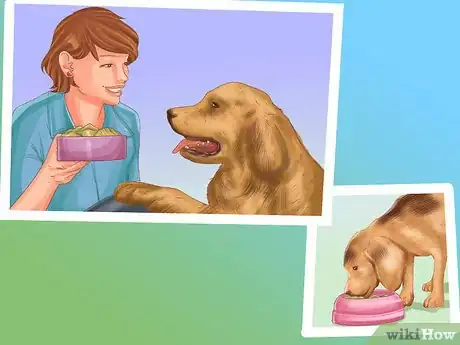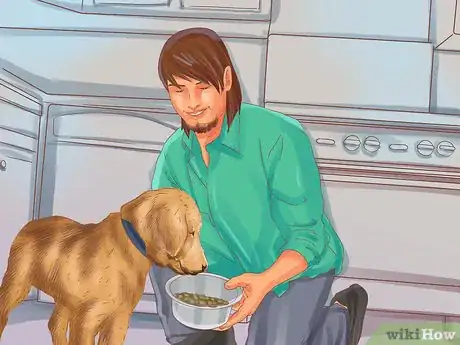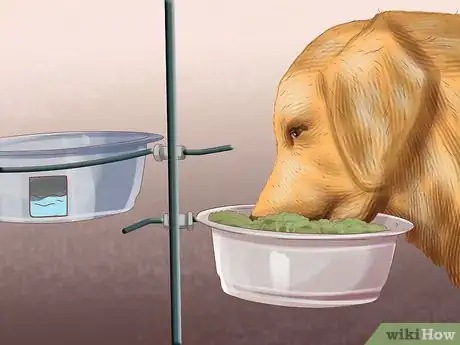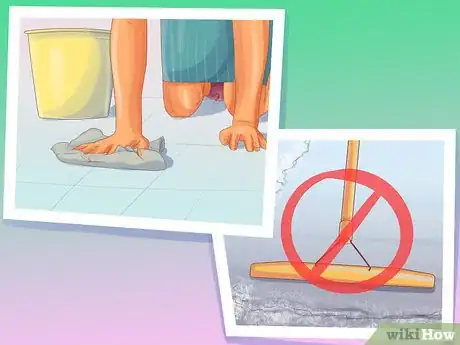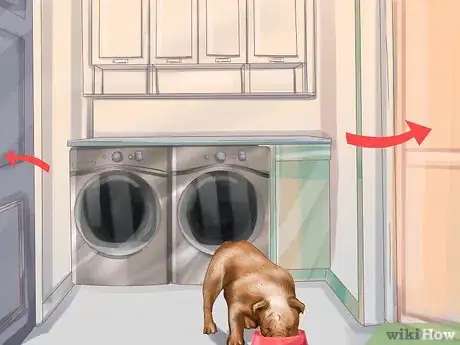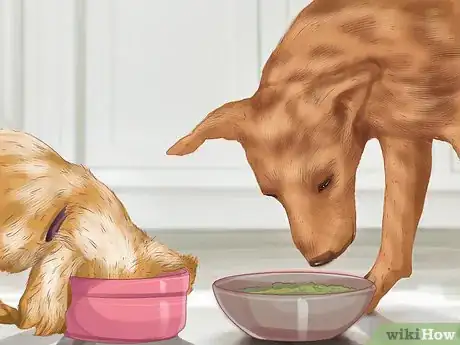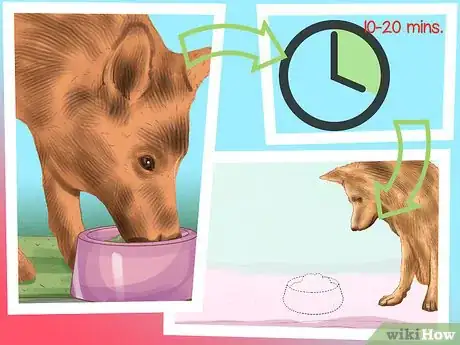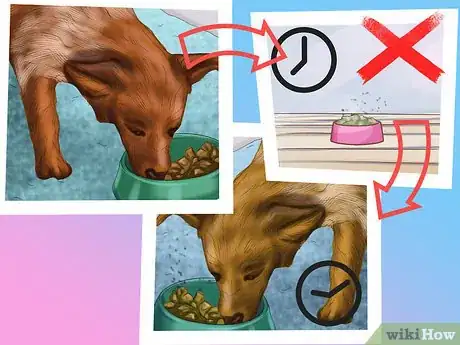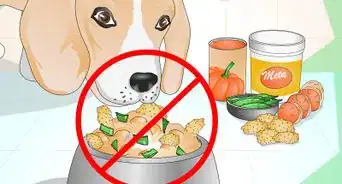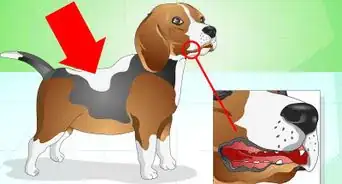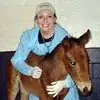X
This article was co-authored by Ryan Corrigan, LVT, VTS-EVN. Ryan Corrigan is a Licensed Veterinary Technician in California. She received her Bachelor of Science in Veterinary Technology from Purdue University in 2010. She is also a Member of the Academy of Equine Veterinary Nursing Technicians since 2011.
This article has been viewed 36,334 times.
Choosing a place for your dog to eat is an important part of being a pet owner. You should take your family’s needs and safety into account when you choose a feeding area for your dog, such as whether you have children or multiple dogs. Once you choose a place for your dog to eat, you can choose a feeding method that complements your pet and family.
Steps
Part 1
Part 1 of 3:
Considering Safety When Choosing a Location
-
1Do not feed your dog near children. Set up a space to feed your dog that is separate from where your children will be during feedings. Teach children to never go near a dog’s food or the dog while it is eating or drinking. It is common for children to suffer from dog bites because the dog is guarding its food and water.[1]
-
2Create separate spaces for multiple dogs. If you have more than one dog, you should feed them separately. Place the dogs’ bowls in separate places. If one or more of the dogs is aggressive, you should feed them in separate rooms.[2]
- Maintain control over the food, and call each dog separately to its bowl.
- Once the dogs have finished eating, remove the bowls from the feeding areas.
Advertisement -
3Don’t feed your dog in the kitchen. If possible, you should avoid feeding your dog in the kitchen. Dry pet food, treats, and supplements can be prone to contamination with Salmonella, which can make both pets and people sick. Avoiding feeding your dog in the kitchen will lessen your chances of becoming ill from germs found in pet food.
- Depending on the layout of your kitchen, you may be able to feed the dog away from the main cooking area but still within the kitchen area.
-
4Avoid feeding your dog outside. Feeding your dog outdoors can welcome unwanted animals, parasites, and rodents to set up shop in or near your pet’s food and feeding area. If your dog lives indoors, you should avoid feeding it outside for these reasons.
- If your dog lives outside, make sure you remove your dog’s feeding dish and any remaining food after each feeding. Clean the bowls thoroughly afterwards, and store them indoors.
Advertisement
Part 2
Part 2 of 3:
Choosing a Practical Location
-
1Designate a specific area for feeding. Be consistent with where you feed your dog. You should feed your dog in the same place every day. Doing so maintains rhythm and routine in your dog’s life. Set up a space with a water bowl, space for a food bowl, and a mat for easy cleanup.
-
2Consider the cleanup. When deciding on a place to feed your dog, you should think about how easy it will be to clean up food-related messes in the space you choose. Consider feeding your dog in a room with tile, laminate, wood, or linoleum floors instead of a carpeted area. These floor types will make cleaning up and disinfecting the area much easier than their carpeted counterparts.
-
3Feed your dog in or near its crate. If you choose to crate your dog, you should consider feeding it inside or near the crate. Feeding your dog regular meals in or near its crate will help your dog adapt to the crate, and gain a sense of confidence and comfort. It also creates a centralized space for messes to be made, making cleanup easier for dog owners.[3]
- You can buy bowls that attached to the walls of the crate. These will prevent your dog from knocking their food or water over.
-
4Consider the mudroom or laundry room. Feeding your dog in the mudroom or laundry room can be a great choice for many individuals and families. These spaces usually have doors so that you can separate your pet from children or other dogs while it eats. Mud rooms and laundry rooms are also more likely to have floor types that are easy to clean, such as tile or linoleum.[4]
Advertisement
Part 3
Part 3 of 3:
Choosing a Feeding Method for Your Dog
-
1Consider your household’s needs and schedule. Before you choose a feeding method for your dog, you should think about the needs and makeup of the household. For example, if you have more than one dog, you should take this into consideration when choosing a method. You should also consider your availability to feed the dog.
- For example, you should take account of when your dog will need to eat and whether you will be home for scheduled feeding times.
-
2Try time limited feeding. Time limited-feeding involves setting out food for your dog, allowing the dog to eat, and then removing the food after a set amount of time, usually 10-20 minutes. This method permits the dog to eat until it's full, but prevents ongoing grazing.[5]
- This method works well for households with more than one dog, as it can prevent scuffles over food that is left out beyond the immediate mealtime.
-
3Consider amount limited feeding. Amount limited feeding consists of providing your dog with a set amount of food and allowing the dog to choose when it consumes the food. When you measure out food at a given meal time, you are giving your dog control over its pace of eating.[6]
- This method works well for households that have only one dog but can cause conflict if you have multiple dogs who may try to consume their friend’s food.
-
4Avoid free feeding. Free feeding refers to making food available to your dog at all times. This allows the dog to choose when and how much they eat. While this is an easy choice for pet owners, there are many pitfalls to this method. Free feeding can lead to obesity in dogs, and leaving food out can be an invitation for insects, rodents, and bacteria to thrive in your dog’s food.[7]
Advertisement
References
- ↑ https://www.ncbi.nlm.nih.gov/pmc/articles/PMC2610618/
- ↑ http://pets.webmd.com/ask-pet-health-11/dog-feeding?page=3
- ↑ http://www.humanesociety.org/animals/dogs/tips/crate_training.html
- ↑ http://people.com/pets/tips-on-how-to-make-your-home-pet-friendly-and-posh-from-hgtvs-nicole-curtis/
- ↑ http://www.petmd.com/dog/nutrition/evr_multi_best_feeding_method
- ↑ http://www.petmd.com/dog/nutrition/evr_multi_best_feeding_method
- ↑ http://www.petmd.com/blogs/nutritionnuggets/2012/feb/jcoates/free_feeding_is_wrong_choice_for_most_dogs-12694
About This Article
Advertisement

